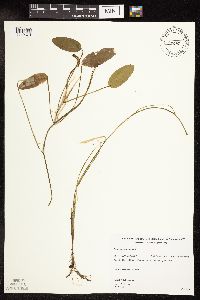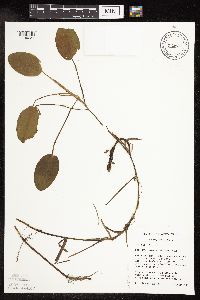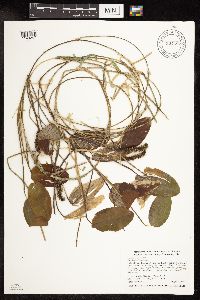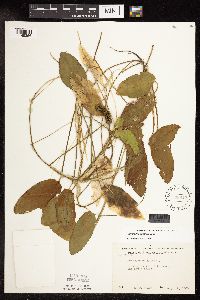Potamogeton natans
|
|
|
|
Family: Potamogetonaceae
Broad-Leaf Pondweed, more...floating pondweed, broadleaf pondweed, floatingleaf pondweed
[Potamogeton natans var. prolixus W.D.J.Koch] |
Rhizomes present. Cauline stems terete, often rust-spotted, 30--90 cm; nodal glands absent. Turions absent. Leaves both submersed and floating, ± spirally arranged. Submersed leaves sessile, rigid; stipules persistent, conspicuous, convolute, free from blade, whitish, not ligulate, 4.5--1 cm, fibrous, not shredding at tip, apex obtuse; blade light to dark green, phyllodial, not arcuate, 9--20 cm ´ 0.7--2.5 mm, base slightly tapering, without basal lobes, not clasping, margins entire, not crispate, apex not hoodlike, obtuse, lacunae absent; veins 3--5, obscure. Floating leaves: petioles lighter green immediately proximal to apex, 5.5--29 cm; blade adaxially light green, elliptic to ovate, 3.5--11 cm ´ 15--60 mm, base cordate, apex acute to rounded; veins 17--37. Inflorescences unbranched, emersed; peduncles not dimorphic, terminal, erect to ascending, cylindric, 4.5--9.5 cm; spikes not dimorphic, cylindric, 25--50 mm. Fruits sessile, green to greenish brown, obovoid, turgid, not abaxially or laterally keeled, 3.5--5 ´ 2--3 mm; beak erect to apically recurved, 0.4--0.8 mm; sides without basal tubercles; embryo with 1 full spiral. 2n = 52. Flowering summer--fall. Quiet or slow-flowing waters of ponds, lakes, and streams; 0--3100 m; Alta., B.C., Man., N.B., Nfld. and Labr. (Nfld.), N.W.T., N.S., Ont., P.E.I., Que., Sask., Yukon; Alaska, Ariz., Calif., Colo., Conn., Idaho, Ill., Ind., Iowa, Kans., Maine, Mass., Mich., Minn., Mont., Nebr., Nev., N.H., N.J., N.Mex., N.Y., N.Dak., Ohio, Oreg., Pa., R.I., S.Dak., Utah, Vt., Wash., W.Va., Wis., Wyo.; Eurasia. Potamogeton natans is the common floating-leaved pondweed of the north temperate ure areas. It is essentially circumboreal and can easily be identified by floating leaves that are almost always cordate at the base of the blade, the petiole with a short band of light tissue at its apex, and the submersed phyllodial leaves. Also, the apex of the petiole usually is bent so that the blade appears oriented in the opposite direction from which the petiole appears to be oriented. One hybrid, Potamogeton natans ´ P. nodosus (= P. ´ schreberi Fischer [P. ´ perplexus A. Bennett]), has been described.
Perennial submersed aquatic herb with rhizomes 1 - 2 m tall Stem: unbranched to sparingly branched, jointed, often with rusty spots. Inflorescence: an upright, dense, cylindrical spike of flowers, emersed, unbranched, 2 - 5 cm long, on a terminal stalk. Stalk cylindrical, 8 - 15 cm long, often thicker than stem. Flowers: greenish, tiny. Stamens four. Anthers two-chambered, with four edge-to-edge sepal-like outgrowths. Fruit: an achene, stalkless, green to greenish brown, 3.5 - 5 mm long, 2 - 3 mm wide, reverse egg-shaped, plump, usually not keeled, wrinkled, with an upright to recurved, 0.4 - 0.8 mm long beak. Submersed leaves: more or less arranged spirally, stalkless, translucent, 1 - 40 cm long, 1 - 2.5 mm wide, narrowly linear (leafstalk-like) with a slightly tapering base and blunt tip, obscurely three- to five-veined, rigid. Stipules axillary, free from leaf blade, whitish, rolled up, 4 - 10 cm long, fibrous. Floating leaves: more or less arranged spirally, on a 5 - 29 cm long stalk, 3.5 - 11 cm long, 1.5 - 6 cm wide, elliptic to egg-shaped with a heart-shaped base and a rounded to pointed tip, 17- to 37-veined, leathery, firmer than submersed leaves. Similar species: Easily identified by the heart-shaped base of the floating leaves and the leafstalk-like submersed leaves. Flowering: mid-June to late July Habitat and ecology: Fairly common in lakes, ponds, and slow streams. Occurence in the Chicago region: native Notes: Plants in the genus Potamogeton are very important to wildlife, offering habitat and food for many aquatic animals. Etymology: Potamogeton comes from the Greek words potamos, meaning river, and geiton, meaning neighbor, referring to the habitat of these plants. Natans means swimming, or floating. Author: The Morton Arboretum Stems 1-2 m, simple or sparingly branched; submersed lvs petiole-like, narrowly linear, 1-4 dm נ1-2 mm, with 3-5-obscure veins; floating lvs elliptic or elliptic- ovate, 5-10 נ2-4.5 cm, obtuse or bluntly short-cuspidate, rounded or subcordate at base, many-nerved; petiole usually much exceeding the blade and flexibly attached to it; stipules axillary, free, 4-10 cm, acute; peduncles 8-15 cm, usually thicker than the stem; spikes dense, cylindric, 2-5 cm; frs obovoid, turgid, with a rather loose, shiny pericarp, 3.5-5 mm, deeply wrinkled on each side, not keeled, or with an obscure dorsal keel; 2n=52. Ponds and slow streams; circumboreal, s. in Amer. to Pa., Ind., Io., and Calif. Gleason, Henry A. & Cronquist, Arthur J. 1991. Manual of vascular plants of northeastern United States and adjacent Canada. lxxv + 910 pp. ©The New York Botanical Garden. All rights reserved. Used by permission. From Flora of Indiana (1940) by Charles C. Deam All of my specimens are from lakes in the northern part of the state. Usually found in all of our lakes. …… Indiana Coefficient of Conservatism: C = 8 Wetland Indicator Status: OBL |


















































































